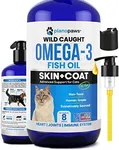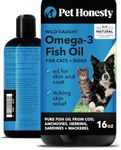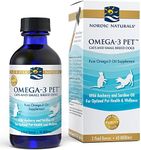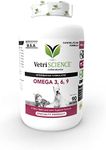Buying Guide for the Best Fish Oil For Cats
Choosing the right fish oil for your cat can make a big difference in their overall health, especially for their skin, coat, and joints. Fish oil is a popular supplement because it provides essential fatty acids that cats can't produce on their own. When shopping for fish oil, it's important to look beyond the marketing and focus on the key specifications that affect quality, safety, and effectiveness. Understanding these specs will help you select a product that matches your cat’s needs and ensures you’re giving them something both safe and beneficial.Source of Fish OilThe source of fish oil refers to the type of fish used to make the oil, such as salmon, sardines, anchovies, or mackerel. This is important because different fish have varying levels of beneficial fatty acids and may also differ in their risk of containing contaminants. Generally, smaller fish like anchovies and sardines are considered to have lower levels of toxins compared to larger fish. If your cat has allergies or sensitivities, you might want to choose a single-source oil. For most cats, any high-quality fish oil from a reputable source will be beneficial, but if you are concerned about purity or sustainability, look for oils that specify wild-caught or sustainably sourced fish.
Omega-3 Content (EPA and DHA)Omega-3 content, especially EPA (eicosapentaenoic acid) and DHA (docosahexaenoic acid), is a key measure of how effective the fish oil will be for your cat. These are the main fatty acids that provide health benefits. Higher concentrations mean more benefit per dose, but too much can cause digestive upset. Fish oils are usually labeled with the amount of EPA and DHA per serving. For general wellness, a moderate amount is sufficient, but if your cat has specific health issues like joint problems or skin conditions, you might want a product with higher EPA and DHA. Always follow dosing guidelines and consult your vet if unsure.
Purity and TestingPurity refers to how free the fish oil is from contaminants like heavy metals, PCBs, and other toxins that can be found in fish. Reputable brands will often have their products tested by third parties and may display certifications or lab results. This is important because cats are sensitive to toxins, and you want to ensure the oil is safe. Look for products that mention being 'molecularly distilled' or 'third-party tested.' If your cat is very young, old, or has health issues, purity becomes even more important.
Form (Liquid, Capsule, or Softgel)Fish oil for cats comes in different forms, such as liquid, capsules, or softgels. Liquids are easy to mix into food and are usually preferred for cats, but they can have a strong smell. Capsules and softgels are less messy but may be harder to administer unless your cat takes pills easily. If your cat is picky or sensitive to smells, you might need to experiment to see which form works best. For most cat owners, liquid is the easiest to use, but the right choice depends on your cat’s preferences and your routine.
Added IngredientsSome fish oils contain added ingredients like flavorings, preservatives, or vitamins. While some additives can make the oil more appealing to cats, unnecessary extras can sometimes cause allergies or digestive issues. If your cat has a sensitive stomach or allergies, look for a product with as few added ingredients as possible. For most cats, a pure fish oil without extra additives is the safest and most effective choice.
Packaging and StorageFish oil can go bad if exposed to light, heat, or air, so packaging matters. Dark glass bottles or opaque containers help protect the oil from light, and airtight seals keep it fresh. Some products require refrigeration after opening. If you don’t use fish oil often, smaller bottles may be better to avoid spoilage. Choose packaging that fits your usage habits and storage space, and always check the expiration date before buying.

















